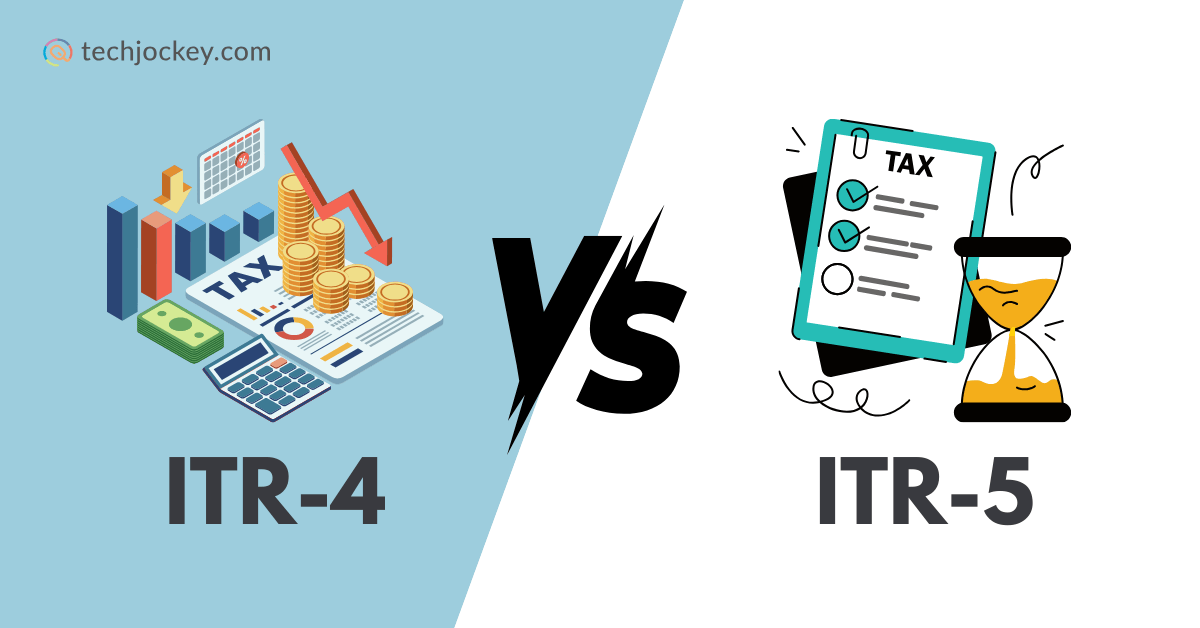
Filing taxes but stuck between ITR-4 vs ITR-5? One wrong pick could mean penalties, notices, and hours of unnecessary hassle. Using reliable Income Tax Software can simplify the process. ITR-4 is built for small businesses and professionals under presumptive taxation, while ITR-5 opens the gate for firms, LLPs, and organizations with detailed income records.
Not sure where you fit in? This blog post discusses in detail about:
Let’s untangle the confusion.
ITR-4, or Sugam as it is commonly referred to, is meant to be used by small taxpayers who choose to use the presumptive taxation scheme in Section 44AD, 44ADA, or 44AE of the Income Tax Act. In presumptive taxation, income is reported at a constant rate instead of having detailed books of accounts. This makes it easier to file taxes among small businesses and professionals.
ITR-4 is for whom?
They can file ITR-4 if their income falls under the presumptive taxation scheme.
Who cannot file ITR-4?
Sources of income allowed in ITR-4
In short, ITR-4 is best suited for small businesses, transport operators, and professionals like doctors, lawyers, or consultants who prefer the simplicity of presumptive taxation.
ITR-5 is more comprehensive form of return, which is used by firms and other entities that are not eligible for filing ITR-4 or ITR-6. It applies to partnerships, LLPs, and other organizations that are required to report detailed accounts of income
ITR 5 is for whom?
Who cannot file ITR-5?
ITR-5 accommodates income from:
| Feature | ITR-4 (Sugam) | ITR-5 |
|---|---|---|
| Who can file? | Resident individuals, HUFs, and partnership firms (not LLPs) under presumptive taxation | Partnership firms, LLPs, AOPs, BOIs, cooperative societies, local authorities |
| Presumptive taxation | Yes (44AD, 44ADA, 44AE) | Not applicable |
| Complexity | Simple, less data required | Detailed, requires full financial reporting |
| What’s the income limit? | Up to INR 50 lakh for professionals, up to INR 2 crore (business turnover) | No specific turnover limit |
| Capital gains | Not allowed | Allowed |
| Foreign income/assets | Not allowed | Allowed |
| Who cannot use it? | LLPs, companies, individuals with income > INR 50 lakh | Individuals, HUFs, companies filing ITR-6, trusts filing ITR-7 |
To choose in between ITR-4 and ITR-5, you have to start by defining your business structure and income type.
In case you are an individual or a small firm that comes under presumptive taxation, you need to file ITR-4. For example: The owner of a small retail shop whose turnover is INR 60 lakh needs to submit ITR-4 under 44AD by reporting 8% of turnover as profit.
In case you are an LLP or a partnership firm with detailed books, you need to file ITR-5. For example, an LLP with a turnover of 5 crore offering consultancy services should submit ITR-5 since ITR-4 does not apply to LLPs.
In case you have capital gains, foreign assets, or income that exceed presumptive taxation limits → Fill ITR-5.
Thus, ITR-4 is meant for simplicity, while ITR-5 is for detailed reporting.
ITR filing is easy if you have a proper guide for the whole process. Below is a gist of how you can file ITR-4 and ITR-5. You can check out a detailed guide on filing ITR-4 and ITR-5 in our blog.
Filing ITR-4
Suggested Read: How to File ITR-4: Step-by-Step Guide for Small Businesses & Professionals
Filing ITR-5
Suggested Read: How to File ITR-5: Complete Guide for Firms, LLPs & Organizations
Conclusion
The decision between ITR-4 vs ITR-5 is simply a matter of knowing your business type, income structure, and compliance requirements.
ITR-4 is the most appropriate for individuals, HUFs, and small firms that are subject to presumptive tax.
ITR-5- It is formulated to be used by partnership firms, LLPs, and organizations that require reporting detailed sources of income and financial statements.
You can eliminate mistakes, fines, and compliance burdens by choosing your type of eligibility and income correctly. Always keep in mind, consideration of the proper ITR form will guarantee you a smooth ride in tax processing.
ITR-4 belongs to small taxpayers with presumptive taxation (individuals, HUFs, firms other than LLPs), whereas ITR-5 is dedicated to firms, LLPs, and entities that need more detailed reporting.
No, LLPs must file ITR-5.
No, capital gains are not allowable in ITR-4. You will need to submit ITR-5 (where applicable) or any other form.
Today's digital economy means single weak password can indeed be catastrophic for any business.… Read More
Artificial intelligence is growing so fast and will grow and grow more faster in the… Read More
Online shopping is changing fast. With the advent of AI assistants, in fact, the way… Read More
Did you know cyberattacks hit business every 39 seconds? That’s right. Every minute counts… Read More
Hackers can’t just keep away by using strong passwords. Here’s the proof: Research says that… Read More
There’s new contender in the smart browser race. A few months after the launch… Read More